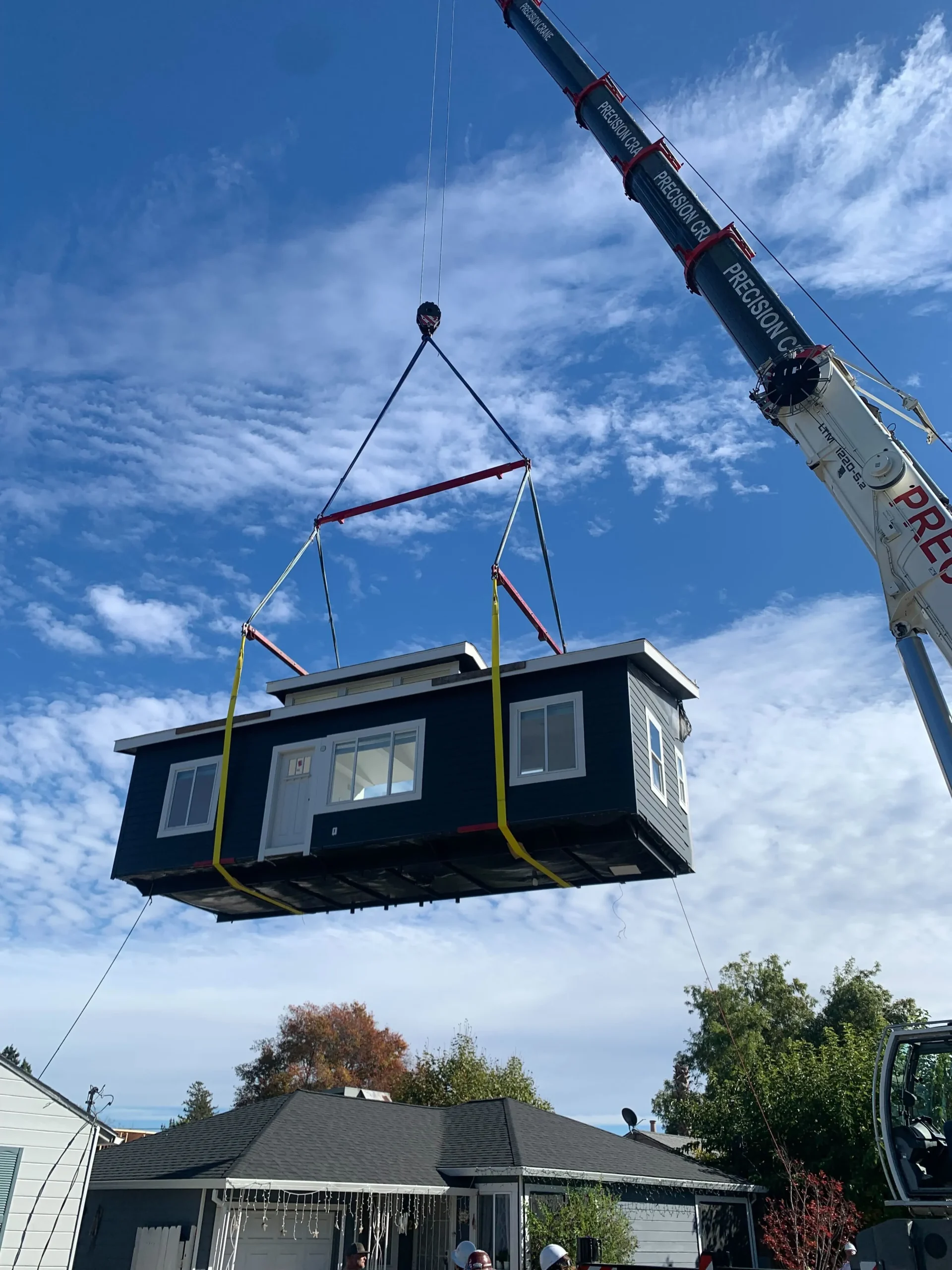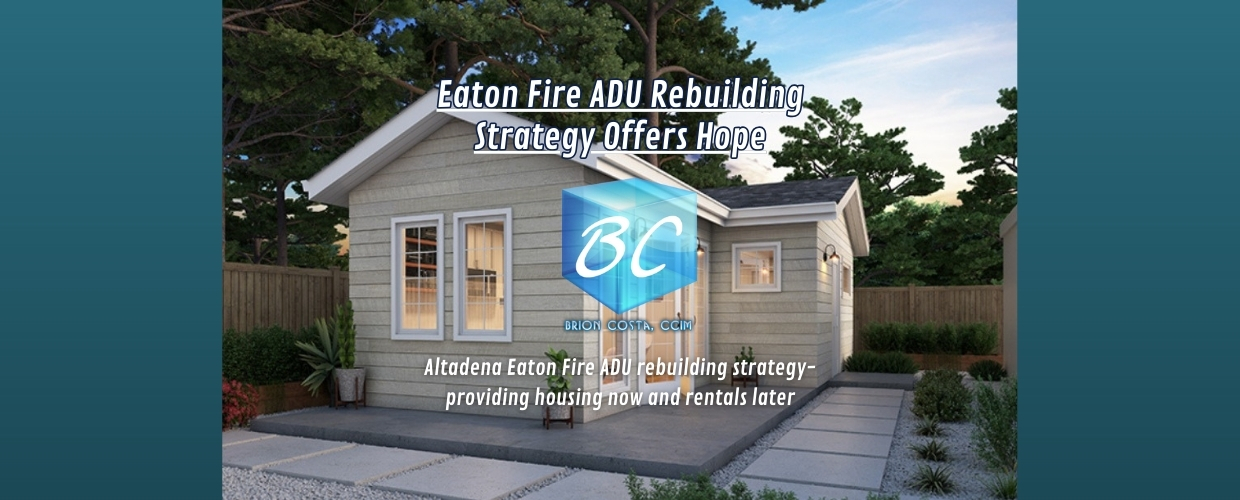Eaton Fire ADU Rebuilding Strategy
Offers Hope
The Eaton Fire’s devastation in Altadena was unprecedented – destroying at least 1,000 structures (some estimates count over 9,000 properties when including secondary structures) and claiming multiple lives. In
the wake of this disaster, our community faces the immense challenge of rebuilding homes, businesses, and lives.
As a proud area resident and commercial real estate professional, I’ve been heartbroken by the losses along our beloved Lake Avenue and beyond. Yet I’m also inspired by an innovative rebuilding strategy taking shape: using Accessory Dwelling Units (ADUs) as the first step in the reconstruction process. This approach – allowing homeowners to quickly build a small secondary unit to live in while their main house is rebuilt – not only speeds up recovery, but ultimately adds new housing to the community.
In this post, I’ll explore how Altadena is rebuilding after the Eaton Fire, how ADUs are playing a key role, and what it means for our housing supply and future resilience.

An aerial view of an Altadena neighborhood shows rows of homes reduced to ash after the fast-moving Eaton Fire. Rebuilding these lost homes will be a lengthy process. Photopilot.com
Altadena's Devastation: Lake Avenue and Historic Homes in Ashes
The toll of the Eaton Fire on Altadena’s landscape is hard to fathom. Entire blocks of our town were reduced to rubble in a single night. Along North Lake Avenue – Altadena’s main commercial corridor – the destruction stretched for blocks. The “Greetings from Altadena” mural near Lake & Calaveras miraculously survived, but the essentials surrounding it went up in flames – the hardware store and the burger joint, the historic coffee shop, churches, schools, grocery stores – all lost. Longtime local businesses that anchored the community are gone. For example, Fox’s Restaurant, a 69-year-old diner and neighborhood institution, was completely destroyed in the fire. “It’s just beyond unthinkable for anybody,” said Fox’s
co-owner Monique King upon learning that the restaurant – a place where Altadenans had gathered for generations – had burned down. Indeed, the devastation along Lake Avenue has been a gut punch to the community’s soul.
The residential neighborhoods fared no better. The fire tore through street after street of homes, from modest bungalows to historic landmarks. Among the tragic losses were several irreplaceable historic houses, including craftsman gems by Charles and Henry Greene. One early 1900s Greene & Greene-designed craftsman home on East Mariposa Street – known as the Serrurier House – was completely destroyed by the flames.
Altadena’s Devastation: Lake Avenue and Historic Homes in Ashes
The toll of the Eaton Fire on Altadena’s landscape is hard to fathom. Entire blocks of our town were reduced to rubble in a single night. Along North Lake Avenue – Altadena’s main commercial corridor – the destruction stretched for blocks. The “Greetings from Altadena” mural near Lake & Calaveras miraculously survived, but the essentials surrounding it went up in flames – the hardware store and the burger joint, the historic coffee shop, churches, schools, grocery stores – all lost. Longtime local businesses that anchored the community are gone. For example, Fox’s Restaurant, a 69-year-old diner and neighborhood institution, was completely destroyed in the fire. “It’s just beyond unthinkable for anybody,” said Fox’s co-owner Monique King upon learning that the restaurant – a place where Altadenans had gathered for generations – had burned down. Indeed, the devastation along Lake Avenue has been a gut punch to the community’s soul.

The burned remains of Fox’s Restaurant, a diner staple in Altadena since 1955. The Los Angeles area restaurant was destroyed overnight by the Eaton Fire on Jan. 7, 2025. SFGATE

Frank Mayor’s historic Altadena home, the McNally House, engulfed in flames. (Photo by Frank Mayor). Daily Bulletin
The residential neighborhoods fared no better. The fire tore through street after street of homes, from modest bungalows to historic landmarks. Among the tragic losses were several irreplaceable historic houses, including craftsman gems by Charles and Henry Greene. One early 1900s Greene & Greene-designed craftsman home on East Mariposa Street – known as the Serrurier House – was completely destroyed by the flames.
Altadena’s architectural heritage also suffered a blow with the destruction of the 1887 Queen Anne-style Andrew McNally House, a local landmark built for the co-founder
of Rand McNally. “Altadena is never going to look the same. Even when we rebuild, it’ll never be what it was,” reflected Altadena Town Council chair Victoria Knapp in the fire’s aftermath. The sense of loss is profound – of homes, history, and the familiar fabric of our town.
Yet, amidst this ruin, Altadenans are determined to rebuild and preserve what they can of the community’s character. Less than four months after the fire, the first rebuilding permits have been issued, and debris removal is largely complete. There is real progress – and a recognition that rebuilding better and smarter is essential. This is where the focus on ADUs has emerged as a creative solution in the recovery — forming the foundation of what is now being recognized as the Eaton Fire ADU rebuilding strategy.

A section of Fox’s Restaurant’s cheerful mural (“Good food served right”) lies amid the rubble after the fire, a poignant reminder of a beloved Altadena diner lost in the blaze. KCRW
ADUs: A Key Part of the Altadena Eaton Fire ADU Rebuilding Strategy
In an effort to jump-start reconstruction, local officials
have hit on an innovative strategy: fast-tracking permits for Accessory
Dwelling Units as the first new structures to rise from the ashes. ADUs –
often called granny flats, casitas, or backyard cottages – are small secondary
homes on the same lot as a main house. Remember here that permits for ADUs are
usually only granted when there is already a main living structure on the
property. In this case, ADU permits are being issued on properties where the
main living unit no longer exists. Why prioritize them now? Because they can
serve a critical dual purpose in Altadena’s recovery.
First, an ADU can provide immediate, on-site housing for a displaced
homeowner. Rather than waiting years for a complete home rebuild, a family can
quickly build a detached studio or one-bedroom ADU and move back to their
property within months. Second, once the primary house is eventually rebuilt,
that ADU transitions into a permanent rental unit or guest house, adding
to the local housing stock. It’s a win-win: families get a place to live right
away, and the community gains much-needed housing for the long term.
Importantly, County authorities have signaled flexibility in permitting these ADUs as a first step. Normally, building a second unit on a lot requires an existing primary residence – but in the disaster context, exceptions are being made. In fact, other California communities have pioneered this approach. After the Tubbs Fire in Sonoma County, officials explicitly allowed residents to build a detached ADU to live in while rebuilding their main residence, even waiving certain fees to encourage it. The reasoning was simple: it lets people return home sooner and jump-starts the rebuilding process. We’re seeing a similar philosophy in Altadena. Homeowners can apply for a disaster rebuild permit to construct an ADU on their cleared lot and use it as temporary housing during construction of the primary house.

An Assessory Dwelling unit is lifted by crane to be put upon its foundation. It is being lifted over the main home and into the back yard. Villa Homes
Essentially, the ADU becomes a bridge home – a foothold back on one’s property. County Supervisor Kathryn Barger has championed cutting red tape for fire survivors, pushing agencies to expedite any permits that get residents back sooner. Only one single-family rebuild permit had been issued by early April, over three months after the fire, which spurred the County to streamline approvals. By focusing on ADUs – which are smaller and faster to build – officials hope to see many more Altadenans breaking ground this spring.
From my perspective, this ADU-first strategy is an innovative and compassionate move. Not only does it provide shelter, but it also gives homeowners a sense of progress and a psychological boost. Instead of an empty lot, they’ll see a home taking shape – even if it’s small for now. And practically speaking, building an ADU typically costs far less and takes less time than an entire house. One Sonoma family, for example, realized it would be “much less time to build an ADU than to rebuild the main residence,” so they lived in a new on-site ADU while the rest of their home was constructed.
We can expect similar stories here in Altadena as dozens of homeowners pursue
this path. Local design-build firms are already fielding calls for
fire-resistant ADU designs. To maximize safety, these units can be designed
with hardy materials (metal roofs, fiber-cement siding, ember-resistant vents,
etc.). In many cases, they might be modular or prefab units that can be
assembled quickly – in fact, developer Rick Caruso has donated 50 prefab homes
by Samara (an ADU builder) to help Altadena fire victims rebuild faster. All
signs point to ADUs becoming an integral piece of Altadena’s rebuilding puzzle.
Boosting Housing Supply and Resilience Through ADUs
In the long run, the embrace of ADUs in our post-fire
recovery — now widely seen as the Altadena Eaton Fire ADU rebuilding
strategy — could significantly benefit Altadena’s housing supply. Even
before the fire, Southern California faced a housing crunch, and Altadena was
no exception. Now, with thousands of homes lost, the shortage is even more
acute. Every ADU built as part of the rebuild will eventually become a new
rental unit or flexible living space once homeowners reoccupy their main
houses. County officials recognize this, noting that adding ADUs during
rebuilding “provides revenue streams for owners while increasing the
availability of rental housing” in the area. In other words, today’s
temporary solution is tomorrow’s affordable housing. Many families will convert
their on-site ADUs into long-term rentals, helping offset mortgage costs and
also providing new apartments in a community that desperately needs them.
This approach also dovetails with California’s broader push
for more missing-middle housing and smarter growth. Rather than simply
replacing what was lost, Altadena has an opportunity to rebuild in a way that eases
the housing crisis. Encouraging homeowners to add an ADU during reconstruction
effectively creates two homes where there was one. It’s gentle density
increase, done in a neighborhood-compatible way. Altadena has many large lots
and backyards, so adding a second small house doesn’t change neighborhood
character – especially compared to the alternative of families selling out and
large developers coming in. By keeping rebuilding in local hands and
incorporating ADUs, we help keep displaced residents in the community and
create new housing options for others (such as teachers, firefighters, young
professionals, or downsizing seniors). As a bonus, new ADUs and homes will be
built to modern codes – including fire-resistant features and energy efficiency
– making the town more resilient and sustainable moving forward. We’re
essentially building back stronger, not just building back.
There are of course challenges with this strategy.
Homeowners must navigate permitting and financing for two construction projects
(ADU and house) instead of one. Insurance payouts may not fully cover an ADU.
And not everyone wants an extra unit on their land. But the County’s one-stop
rebuilding center is actively guiding residents on ADU permits, and there are
incentives like fee waivers for units under 750 sq ft in some cases.
The community mindset is also shifting to embrace ADUs – many see it as a
practical way to help neighbors and contribute to the recovery. As a longtime area
real estate broker, I’ve had clients already asking about adding an “in-law”
unit during their rebuild so they can house a friend or relative who lost a
home. That spirit of helping each other is what makes Altadena special, and
it’s on full display during this recovery.
Rebuilding Altadena: The Road Ahead and Expert Advice
Today, driving through Altadena, you can see both
devastation and determination. Cleared lots and foundation stumps are
interspersed with the first signs of renewal – a construction crew framing an
ADU here, a Habitat for Humanity home going up there. Rebuilding an entire town
will take years, but momentum is finally building. “It shows that we can
rebuild – and rebuild in a safe and effective way,” Supervisor Barger said
recently, celebrating groundbreakings like that of Margot Steuber’s new home. “I
want to make sure that we provide the support that [residents] need to rebuild
their lives,” she added. That support is evident in initiatives like
expedited permits and creative housing solutions. As the first families move
into their newly built ADUs, hope is replacing despair. One Altadena couple who
will be living in a one-bedroom cottage in their backyard by summer and who plan
to oversee their main house construction from next door said, “We’re home,
and that’s what matters,”, despite the cramped quarters. Stories like these
will multiply in the coming months.
From a commercial real estate perspective, I’m optimistic
that Altadena’s commercial corridor will also revive alongside the housing.
Small business owners like Monique King of Fox’s are determined to rebuild if
they can. New development may come, but with community input and historical
sensitivity – we’ll likely see a mix of restored favorites and new enterprises
on Lake Avenue in a few years’ time. The increase in on-site ADUs will mean
more residents back in town sooner, which is good news for local shops and
restaurants. More rental units also mean more customers and workforce living
locally. In essence, the ADU strategy is not just about individual homeowners –
it’s part of reigniting Altadena’s economic engine and sense of normalcy.
As we look ahead, one thing is clear: rebuilding after a
disaster is a complex process that touches on residential and commercial
considerations alike. If you are a property owner in Altadena charting your own
rebuild – especially if you’re considering adding rental units or redeveloping
a site that had mixed uses – it’s crucial to plan wisely. Consult a
qualified expert, such as a Certified Commercial Investment Member (CCIM), for
guidance. A CCIM like myself can help evaluate the feasibility, zoning,
financing, and long-term investment implications of incorporating an ADU or
any commercial component into your rebuild. We bring both market insight and
analytical tools to ensure your redevelopment maximizes value and complies with
all regulations. Rebuilding is a rare opportunity to reimagine your property,
and getting professional advice will help you make the most of it while
avoiding pitfalls.
Altadena’s journey to recovery is just beginning. The scars
of the Eaton Fire will be with us forever, and we mourn what was lost – from
historic Craftsman homes to mom-and-pop cafes. But in forging ahead with
innovative solutions like ADUs, our community is also planting the seeds of a
stronger future. Each new little dwelling that rises from the ashes is a sign
of resilience and renewal. As your local CCIM and neighbor, I’m here to help
navigate the challenges and seize the opportunities in this rebuilding process.
Altadena will rebuild – one ADU, one home, one block at a time – and together
we’ll ensure that the Altadena of tomorrow retains the soul, community, and
hope that have always made this foothill town so special.
Brion Costa, CCIM
Century 21, Commercial
626-695-7385
DRE#: 00939864


